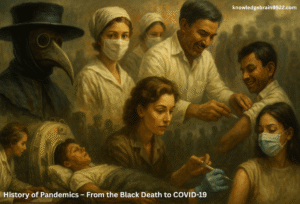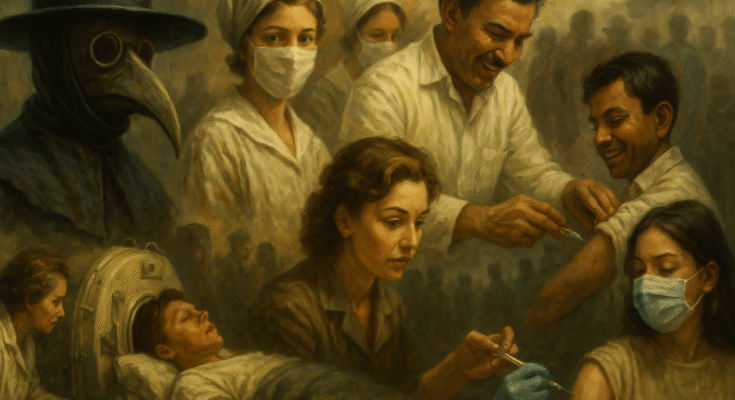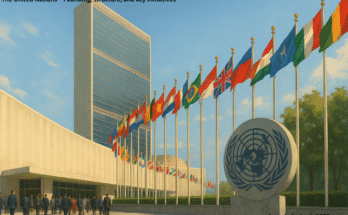
The Pandemic Story The pandemic history from COVID-19 through the Black Death Overview illnesses that have spread around the world are commonly called pandemics. They’ve had an enormous effect on the human story and have tested the capacity of society to bounce back to the beginning. Every single pandemic, from the beginning of Black Death to the current COVID-19 epidemic, has brought suffering for the human race, tension in society as well as advances in science. Recognizing the causes, impacts and the responses to previous epidemics will allow us to minimize the risk coming in the near in the near future. The article examines the major epidemics of the last seven centuries, and examines the different responses from various categories, and offers ideas that can apply to our present modern day.
Between 1346 and 1353, the Black Death
Origins and Dispersal
In 1347, after Genoese merchant vessels were able to flee a war that took place in Kaffa (now Feodosia, Ukraine) in 1347 and brought the deadly disease Yersinia pestis that was the cause of the Black Death, to Sicily. Thanks to trade routes, the disease spread across Europe, Asia, and North Africa. Between 75 and 200 million individuals over five years. It’s about half Europe’s population. Additionally, there’s an undetermined quantity of people who live in Africa in addition to Asia.
Mortality and Manifestations
Three different types of the disease have been identified as: pneumonic (lung inflammation in the lung) along with Septicaemic (blood inflammation) and Bubonic (enlarged lymph nodes). The most fatal illness, pneumonic plague could be transmitted through respiratory droplets and swiftly kills the victims. Many families died as trade slows settlements with chaos and terror. chaos.
Economic and Social Effects
Due to the large number of dead due to the huge amount of deaths in the system, it was thrown into turmoil by the remaining workers who had the right to demand more money. Farmers were forced to rely on to make pasturage while the farmland was abandoned. Political and economic systems were influenced by tensions between social groups and peasant rebellions like 1381, the English Peasants’ Revolt in 1381. The clergy was killed in the midst of a disease, and then religious groups like the Flagellants rose up, begging for God to pardon the Church. was plagued by problems with their faith.
Medical Reactions
Based on the Medieval medical theories, this disease came about as a result of divine retribution. miasma, or filthy air. In order to stop “contagion,” plague doctors had masks on that contained aromatherapy herbs, however cures were never discovered. At first of the year Venice 1377, quarantines were used to prevent the spread of illness within ports by the blocking of ships for a period of forty days (hence the word “quarantine “)). This technique remains in use to protect public health.
The Pandemic of the Third Plague (1855-1960)
The global plague epidemic that started in Yunnan, China, in 1855 was borne via steamships and railway lines across India, Hong Kong, in addition to other areas. In India across the whole nation, over 15 million were killed. Western scientists such as Alexandre Yersin and Paul-Louis Simond established the basis for studying the bacteriology of epidemics and bacterial diseases by confirming the existence of bacterium and rats as agents.
Smallpox: Vaccination-Assisted Eradication
The History of the Scourge of Smallpox Variola, the virus which caused smallpox has killed around 20-30 percent of people and left those who survived with scars that are constant reminders of how devastating this illness might be. In the years following European contact, it decimated indigenous peoples in the Americas as well as destroyed civilizations including Aztec as well as Inca. Inca and Inca. Aztec. It was spread by touching directly as well as through drops of airborne particles.
Immunisation along with Jenner’s vaccination
Variolation was an illness that was intentionally caused which was a mild ailment and was a way to protect yourself since the start in the 1800s. The year 1796 marked the first year that Edward Jenner showed protection against smallpox by vaccination of James Phipps, then eight years old, with the cowpox. Jenner’s approach, which she described as “vaccination,” gained popularity quickly. Jenner’s method, she referred to as “vaccination,” gained traction rapidly. World Health Organisation and governments conducted extensive vaccination programs during the 20th and 19th century. This resulted in the first natural smallpox case in 1977 and then the complete elimination of smallpox in the year 1980. The smallpox virus is the sole human illness that has been eradicated.
Flu in Spain (1918-1919)
A Pandemic Never Seen Before
The first virus to be patented known as”the influenza (H1N1) virus first discovered in the following years in World War I. It was called”Spanish Flu” due to its nature of it being called “Spanish Flu” since neutral Spain was the first nation to have outbreaks, caused the deaths of more than fifty million people in the globe. It it spread to about a third of the people, that is more than the actual conflict.
Demographics and Virulence
In the event of an increase in immune response (cytokine storm) The 1918 influenza strain led to the death of a large number of adolescents who were in good health, as opposed typical influenza strains that typically affect people who are old or young. The spreading of the virus increased inside military camps and trenches that had troops living close proximity.
Measures for Public Health
The first treatments that did not require the use of drugs included the necessity for the removal of masks from theatres and schools, as in public gatherings becoming prohibited. The efficacy of these remedies were hampered by the fact that transparent and truthful reporting was delayed due to restrictions on reporting during wartime in countries who were fighting. Volunteers and nurses helped the sick under gruelling conditions in cities such as San Francisco imposed fines for not revealing violations.
Legacy
The 1918 pandemic of influenza highlighted the importance of a worldwide surveillance system, in addition to spurring advancements in the discipline of virus research. In order to combat these risks, organizations similar to the U.S. Centres for Disease Control and Prevention (CDC) were established and the annual vaccination for influenza was introduced within the post-1918 programmes.
The Rise of Vaccination and the Polio Epidemics
The Paralysing Effects of Polio
In the early 20th century, poliomyelitis–caused by the poliovirus–became an epidemic that paralysed thousands of children every year. Public panic and institutionalisation in “iron lungs”–negative-pressure ventilators–were caused by outbreaks in the 1940s and 1950s.
Vaccines for Salk and Sabin
It is a vaccine for Inactivated polio (IPV) developed in the late Jonas Salk, significantly decreased instances across the US during the year 1955. Because it was simple to use the mouth vaccine against polio (OPV) was first developed in the latter half of 1960 by using a live virus, which allowed for all over the world to receive this vaccine. Together, WHO, Rotary International as well as UNICEF could eliminate the polio virus. Wild Poliovirus Type 2 was declared extinct in the year 2015. Type 3 was declared extinct in the year 2015. Type 3 virus was declared extinct by the year 2019. Type 1 remains active in Pakistan and Afghanistan by 2021.
HIV/AIDS’s Origins and Worldwide Spread (1981-Present)
The year 1981 saw strange cases of infections among gay men were recorded in the annual report by U.S. health officials. In 1983, the root cause of retrovirus HIV was identified. HIV/AIDS is spread across the globe due to sexual contact unprotected and the sharing of needles with the sub-Saharan region of Africa, which is the one that has the highest rate. A total of 30 million were diagnosed with HIV at the middle in the 90s. More than 2 million died due to the illness each year.
Changes in Therapy
Since antiretroviral therapy (ART) first became available in the second half of the 1980s and was added to highly vigorous treatment regimens in the middle of the 1990s, HIV was reduced from becoming a fatal illness to being a chronic disease which was treatable. While ART is now accessible, 27.5 million people died because of AIDS before 2021. Pre-exposure prevention (PrEP) and injection programs for needles, distribution of condoms and information campaigning are crucial steps to reduce the risk of developing HIV.
MERS, Emerging Coronaviruses, and SARS
The case of Guangdong, China, to additional 29 countries, SARS (Severe Acute Respiratory Syndrome) was a major issue for more than eight thousand people over the last 10 years, and the mortality rate for each incident is 10. The quick identification of the case in addition to hiding and isolation was crucial to containment which stopped the spread of SARS within two months.
MERS (since 2012)
With a mortality rate of 34% with more than 2,500 incidents, Middle East Respiratory Syndrome first became apparent in the period in Saudi Arabia and was disseminated via camels, human beings as well as camels, and there is no transmission from human to human. Prevention of hospitalization was the main focus in localized outbreaks.
Pandemic of COVID-19 (2019-present)
Origins and Worldwide Dispersion
A new coronavirus known as SARS-CoV-2 has been discovered within Wuhan, China, in December of this year. It is believed that the WHO is announcing COVID-19 as to be an outbreak by March 2020. Over 400 million cases and 5.8 million deaths were reported worldwide within just two years. It is likely that the numbers will be exaggerated.
Measures for Public Health
Amazingly innovative strategies were utilized by the authorities. These included mass testing of masks, as well as locks for international travel restrictions as well as social aversion. Even though there were enormous financial costs to the community such as quarantine and tracer of contacts prevented the spread of.
Therapeutics and Vaccination
The vector vaccines to fight viral diseases (Oxford-AstraZeneca, Johnson & Johnson) and mRNA-based vaccines (Pfizer-BioNTech, Moderna) were approved to be used as emergency vaccines in 2020’s final year. More than 8 billion doses were dispersed across the world within less than a year. The results were amplified by monoclonal antibody and steroids (dexamethasone) in addition to antiviral medicines (remdesivir). The countries with higher incomes have higher than 70% of their population covered by vaccination. In contrast, a number of low-income countries were below 10 percent and this suggests that vaccination inequality is still a problem.
Economic and Social Effects
The supply chain was disrupted, and economics fell into recession, and gap between the rich and poor increased with COVID-19. In the end, job loss and the isolation caused the increase of mental health concerns. For a lot of kids that attended schools, closing them resulted in the loss in their educational opportunities. However, it was also a catalyst for international collaboration in the design of vaccines, telemedicine and in remote working techniques.
Knowledge Acquired and Future Readiness
Increasing Monitoring
The early detection of infections and the transparent reportage is vital. It is possible to prevent infections by spending money on One Health programs that follow the spread of infectious diseases to wildlife, mammals and even human health.
Global Cooperation: Because outbreaks spread beyond the borders of national boundaries, WHO, national public health authorities, as well as regional alliances have to collaborate on their response. Collective resilience could increase by exchanging data making regulations, exchanging information, and allocating resources in an equitable manner.
Acceleration of Vaccine R&D
The rapid development of COVID-19-related vaccines shows the potential of international collaboration as well as financial support as well as flexibility with regard to the regulatory process. The timescale for the future could be shortened by the creation of the appropriate technology for manufacturing and vaccines throughout all countries.
Infrastructure for Public Health
Protections are strengthened through aid from the health system of care, laboratory capacities, and trained staff. They are frontline facilities that provide health education and vaccinations. are clinics for the community, along with health specialists in the local communities.
Examining Socioeconomic Factors
People who are particularly vulnerable are more vulnerable to the spread of diseases that are widespread. Health insurance coverage for everyone like the paid sick days and social security nets reduce the likelihood of suffering from illness, and help to improve the conformance to health-related standards generally.
To conclude
Since the time of medieval the plague physician and today’s vaccine scientists, the fight against the spread of pandemics throughout human history has led to scientific advances and changes in society. In spite of the harm caused by each catastrophe, advances in the field of epidemiology, public health, as well as microbiology have significantly enhanced our abilities to determine the source, treat and stop new infections. Like COVID-19 has shown in particular, an absence of faith can be fatal. There is a way to prepare to fight the next outbreak through learning from past events and funding surveillance. This will ensure an equal opportunity to access medical services in addition to enhancing the solidarity of the world community. The lessons learned from the past will help us advance, and inspire us to take action ahead of when the most difficult events in the history of mankind repeat.



